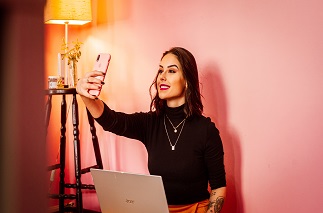Posts

Luis Miguel Romero Rodríguez: “AI is an opportunity to innovate in evaluation”
Romero-Rodriguez argues that the impact of AI cannot be ignored, as he argues that when the teaching-learning process and its evaluation are properly planned, AI can represent a great support.

Luis Miguel Romero: The Dilemma of Influencers and Brand Ambassadors
Influencers and brand ambassadors have become a very popular marketing tool in recent years. However, their improper use can lead to a number of risks, such as future reputation problems, inconsistent communication, and fraud.
Brands should be aware of these risks when choosing a digital prescriber. It is important that the influencer or brand ambassador is aligned with the brand's personality and that their target audience is appropriate. It is also important to ensure that there is no fraud on social media

Owned media, influencer marketing, and unofficial brand ambassadors: differences between narratives, types of prescribers, and effects on interactions on Instagram
In the current era of the attention economy, users find themselves in social networks over-saturated with advertising that tends not to catch the public’s attention or have great credibility. In this sense, brands are trying to get closer to their audiences by using non-invasive, user-generated storytelling strategies with a more natural and experience-focused message. This research aims to compare which narrative elements used by the official accounts of 5 Ibero-American nation brands on Instagram and by the users (UGC) of hashtags promoted from those official accounts generate greater organic interaction on that social network (likes and comments). With a correlational view, we seek to compare whether the promotion of countries generates greater interaction between those generated by owned media and by users (UGC). For this purpose, two analysis sheets were designed and validated to perform quantitative, descriptive, and correlational content analysis and were applied, on the one hand, to 5 official profiles of Ibero-American countries (Argentina, Ecuador, Mexico, Panama, and Venezuela) and on the other hand, using the hashtags promoted from these official accounts, the 100 posts of user-generated content (UGC) with greater relevance according to the platform were chosen. The main results show that Reels reach almost five times higher than any other type of posts in UGC accounts, while on the contrary, in corporate accounts, they are the types of content with the least interactions. Unlike what one might think, contests (giveaways) on official accounts generated fewer likes and social responsibility content, and posts featuring influencers and celebrities also failed to achieve significant interactions. Overall, official accounts generate the same amount of likes as UGC but significantly fewer comments. Brands only outperform UGC in likes in individual Photographs or Photo Rolls, while UCG outperforms brands in Reels for both metrics.

Iconographic-symbolic analysis model of Corporate Visual Identity (CVI): Application test on pharmaceutical companiesin Spain
This study presents a taxonomy to analyze the Corporate Visual Identity (CVI) through the theoretical construction of iconographic variables. The instrument was validated by an expert panel and a pilot test that examined the CVI of the 50 leading pharmaceutical companies in Spain. The instrument was organized by graphic elements: iconographic sign, linguistic sign, and plastic sign, and helped to catalog the symbolic components of CVI. In the Spanish case, due to its cultural and social context, pharmaceutical brands prefer typographies with no strokes, simple lines, capital letters, and round and medium strokes.

Corporate visual identity of financial institutions in Spain: iconographic-symbolic web content analysis
This research examines the visual identity of the 72 leading financial institutions operating in Spain through an ad hoc analysis model of iconographic-symbolic content. For this purpose, an analysis sheet is designed and validated, with theoretical variables where each sample object responds to categories grouped by similarity and under formal criteria obtained from the study of all the literature related to the fundamental graphic elements –iconic, linguistic, and plastic sign– and their application to the virtual world. The results show that legibility and modernity are priorities in the majority of the sample corpus, with a typographic style without finials, simple strokes, capital, round and medium-thickness characters. In addition, the entities prefer other values apart from professionalism and stability, such as closeness or trust, making use in the compositions of a quality range of 2-3 color combinations in which the balance between cold and warm colors is appreciable. For the sake of responsive web design, financial institutions are inclined to stay on the sidelines and not do without any elements in their visual identities, leading the way in the use of logotypes

Toward state-of-the-art on social marketing research in user-generated content (UGC) and influencers
This study examines the research that has been conducted on user-generated advertising content in the social marketing strategies of commercial brands to understand the phenomenon, explore academic interest in the topic and identify areas of limited thematic coverage. A systematic review of existing scientific literature in the Web of Science (WoS) and Scopus was carried out using the PRISMA protocol. A co-occurrence matrix was used to review emerging topics on user-generated content (UGC) and influencer marketing, allowing the identification of articles (n = 59) related to the objective of this research. Most research has analyzed UGC in images or text, but only very few have addressed videos and other digital formats (such as reels, image carousels or podcasts), although there is sufficient work focused on Twitter, Facebook and YouTube. There was no evidence of work exploring the effects, repercussions and possible dangers of uncontrolled brand exposure through Unofficial Brand Ambassadors. The literature review has allowed finding important areas of future research that the scientific community has not sufficiently addressed. Likewise, this work shows structurally several classifications of UGC, which will facilitate future research to deepen and broaden these categories.

Digitalization of Corporate Communications: a multi-stakeholder approach
The forced confinement caused by the COVID-19 health crisis has required companies to change their production dynamics, digitalizing workplaces, abandoning physical spaces and infrastructures, focusing on promoting remote work, as well as mechanics and dynamics of organizational communication exchanges with their different stakeholders through digital channels, in order to maintain their production processes and improve efficiency in this new and changing scenario. However, given the situation’s urgency, the digitalization process has not been gradual. From one day to the next, organizations have had to opt for these mechanisms to give continuity to their productive activities and business plans. This has meant, among other things, that internal stakeholders of the organizations have had to bear, in many cases, labor costs while getting used to the dynamics of remote work and sharing physical space with family members.

Corporate Social Responsibility communication of male luxury fashion brands: analysis on Instagram, Facebook and TikTok
This study aims to analyze the content on corporate social responsibility (CSR) of Gucci, Prada and Ermenegildo Zegna on the social networks Instagram, Facebook and TikTok in order to examine the focus of the publications of these luxury brands, what type of content is more frequent and which ones generate more interaction and engagement. An interpretive content analysis of a sample of 92 posts on CSR published between December 2021 and June 2022 is used. For this purpose, an analysis sheet validated through theoretical constructs and pilot testing is used. Most of the social responsibility content of the fashion brands analyzed is linked to the use of sustainable materials, the protection of natural spaces and, in the particular case of Prada, the protection of the oceans. The posts that achieve the highest interactions are videos and photo reels. Although the strategies that significantly increase brands' reach on social networks are collaborations and joint posts with other fashion brands, as is the case of Gucci with NorthFace and Prada with Adidas. Also, one of the main findings of this research has been to identify that brands may be using TikTok – perhaps experimentally – to reach stakeholders in Asian countries, especially China, where other platforms such as Instagram or Facebook may have a more limited reach. This research shows that the social responsibility activities of luxury fashion brands leverage the content marketing strategy in social networks. It also demonstrates the importance of the Asian market (mainly Chinese) in the outreach strategies of brands, as is the case of Gucci and Prada, which bet on CSR activities for the protection of the Asian tiger in the framework of the year of the tiger in the Chinese horoscope, as well as the publication of certain content on TikTok.

Happiness management: key factors for sustainability and organizational communication in the age of Industry 4.0
Happiness is a personal and social concept that we all aspire to at some point. In our lives, it can come to be considered as a tool that facilitates human development in its various individual and collective dimensions. It is even a topic that has led to quantitative organizational indices that assess the population’s happiness and wellbeing. From this perspective, happiness is not only a utopian guide or an inspirational attribute but also becomes an organizing principle to improve governance and public policy development. This is how, in a competitive and complex environment, happiness can promote the development of a nation if it is oriented toward improving the productive results of human capital from the integration of actions by companies and governments to raise the perception of this construct

Hola Followers! Content Analysis of YouTube Channels of Female Fashion Influencers in Spain and Ecuador
The objective of this article is to analyze the contents and unconventional advertising narratives of the eight most important women in the world of fashion in Spain and Ecuador in relation to the number of followers and points of view, in order to identify the discursive and esthetic strategies and narratives that may reflect the keys to their experience as prescribers, through a content analysis based on the interpretation of the five most viewed videos between 2018 and 2019 from four Spanish to four Ecuadorian YouTube channels (ME = 40) based on a three-round Delphi analysis sheet with a validity of W = 0.828 and α = .947. The content is analyzed from a qualitative perspective, which allows an in-depth exploration of the dimensions and indicators of impact and influence on YouTube channels. The research presents the findings that the influencers reviewed use crutches, idioms, and set phrases to identify with their audience. The audiovisual narrative is simple, maintaining its amateur style. Advertising positioning in the channels analyzed is given by identifying the brand in the spoken discourse, the presence of brand logos, advertisements and promotions, and the presence of products of the sponsoring brands.
